“When I want something for myself, I make it a project.”
That’s how Randall Fishman, a retired jeweler from New Jersey, explains his entry into the world of electric-powered flight. His journey began in the late 1970s when he was flying ultralights and working at a jewelry store.
“I wanted to ride my bike to work and there was a big hill I had to go up,” he recalled. “I didn’t want to get all sweaty, so I used an electric motor powered by a battery for the bicycle to get me up the hill.”
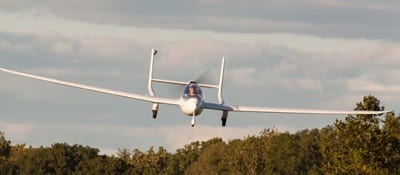 Having tackled electrically powered ground transportation, Fishman began to explore ideas for electrically powered ultralights.
Having tackled electrically powered ground transportation, Fishman began to explore ideas for electrically powered ultralights.
Most ultralights are powered by two-stroke gasoline powered engines, he said.
“They are very loud. You can’t fly without a headset or earplugs. There is a lot of vibration. When you’re done flying the ultralight your whole body is vibrating,” he explained.
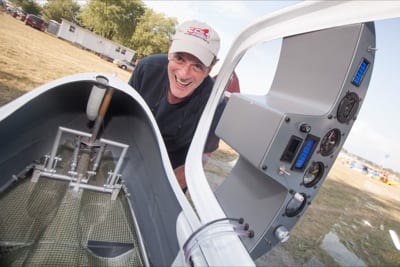 Fishman bought a Trike and started to experiment with off-the-shelf electric motors. The first flights were successful, except that the 18-horsepower motors kept burning out.
Fishman bought a Trike and started to experiment with off-the-shelf electric motors. The first flights were successful, except that the 18-horsepower motors kept burning out.
“The motors were not designed for that,” he said. “They kept burning out because I was asking too much from them.”
He enlisted the help of a friend, Erwin Rodger, a mechanical engineer, to develop a more successful powerplant that runs on lithium polymer batteries, similar to what cellphones and radio-controlled aircraft use. With the new powerplant, he succeeded in powering the trike with electricity.
He founded the Electric Aircraft Co. and began offering the ElectraFlyer Trike for sale. The Trike was a big hit, and soon Fishman began offering systems to convert other ultralights to electric power.
In 2008 Fishman’s second design, the Electra Flyer-C, was introduced to the aviation world (pictured below).
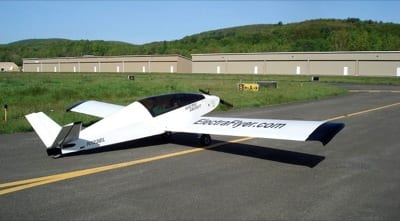 “We converted my single-place Moni motor glider to an electric airplane,” Fishman said.
“We converted my single-place Moni motor glider to an electric airplane,” Fishman said.
Because the airplane was designed as a glider, it has the lift to drag ratio that made it an obvious choice to use as a test platform, he explained.
The project was not without its skeptics.
“I still get emails from people who say ‘this is b.s., you can’t do it, the numbers don’t work out’,” he said. “These people don’t understand how it works.”
Most of the skeptics are under the impression that the aircraft can only stay aloft for 10 minutes or so, then it must land because it is out of power. That’s because most people know about battery powered aircraft from the radio-controlled aircraft world, he said.
“These people are under he impression that the engine will be run at full power for the entire duration of the flight, which is what you do with an RC airplane,” Fishman explained. “When the RC batteries are run like that, they run out in about 10 minutes and get so hot that you can’t even hold them in your hand.
“In the electrically powered aircraft, the motor is run at full power for about a minute or so for takeoff,” he continued. “When the aircraft reaches altitude, the engine power is pulled back to about 30% power.”
At this reduced power setting the aircraft can stay aloft for an hour or so, which, Fishman noted, is about as long as most recreational pilots stay in the air for sightseeing trips around the local area.
“Unlike RC batteries, the aircraft lithium batteries don’t get hot in flight because the slow discharge rate keeps the batteries from heating up,” said Fishman. “The batteries are housed in a stainless steel box and there is a scoop on the upper and lower wing. It allows air to flow over the batteries to keep them cool during flight.”
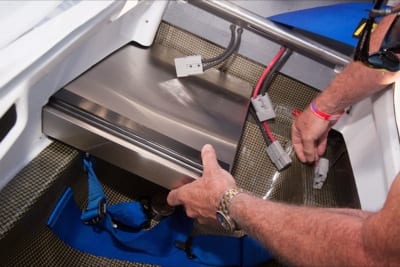 The pilot knows how much power is in use by virtue of a ammeter and how much is left in the battery by the voltmeter.
The pilot knows how much power is in use by virtue of a ammeter and how much is left in the battery by the voltmeter.
The batteries can be recharged in flight by the pilot flipping a switch and putting the aircraft’s nose slightly down to allow the propeller to turn. The rotation of the propeller powers an alternator. After the flight, the batteries can be recharged with either a 110-volt or 220-volt charger.
The best part of electric flight, according to Fishman, is the quality of life aspect.
“It’s so much quieter, you’re not polluting with noise and exhaust, there isn’t much vibration from the engine, or exhaust gas smell or soot from the engine, so it is much more comfortable,” he said.
In addition, since the Electra Flyer-C was developed from a motorglider, it can take advantage of thermals to gain altitude just as a conventional glider does.
The operational costs of the electrically-powered aircraft are considerably lower than for fossil fuel-powered aircraft.
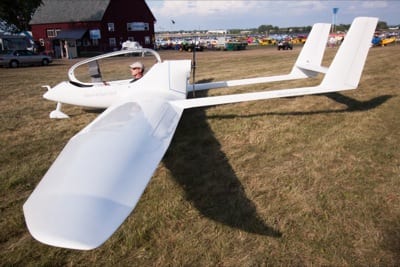 “Electricity costs .11 to .12-cents per Kilowatt hour, depending on where you live,” said Fishman. “You can fly for about two hours for a dollar.”
“Electricity costs .11 to .12-cents per Kilowatt hour, depending on where you live,” said Fishman. “You can fly for about two hours for a dollar.”
The ElectraFlyer-C runs for an hour and a half and costs about .75-cents to recharge, he noted.
It sells for $45,900, which includes battery packs, a charger and an open trailer.
Fishman’s expertise is in electric propulsion. For the airframe design work he brings in engineers, who approach the factories that produce the design. That’s how the ElectraFlyer -ULS came to be. The twin-boom tail design sports a 20-horsepower direct-drive engine capable of cruising at 40 mph. The bubble canopy, coupled with the all carbon-fiber construction, gives the ultralight a space age look.
Fishman came up with the initial concept of the ULS and many of the details, such as the steerable nosewheel and the pusher prop.
The ElectraFlyer ULS sells for $59,000 and comes ready to fly.
The only downside of Fishman’s designs is that they are one-place. Fishman pursued the concept of a two-place design, the ElectraFlyer X, which debuted at AirVenture 2009.
“It was shown off at Oshkosh and people loved it,” he said. “I won the Lindbergh Aviation Award with it and received $10,800, which is how much ‘The Spirit of St. Louis,’ Lindbergh’s airplane, cost in 1927.”
The Lindbergh Aviation Award is given annually to individuals whose work has made significant contributions toward the concept of balancing technology and nature.
Fishman wanted the design to be licensed under the Light Sport Aircraft category, but ran into a snag with the FAA.
“The FAA was talking about a long time for approval — 10 years or more — because they want more real-time experience with electric flight before they certified it,” he said.
Fishman is hopeful that data gleaned from flights of the ElectraFlyer ULS will satisfy the FAA and eventually lead to the certification of electric propulsion for Light Sport Aircraft.
For more information: ElectraFlyer.com

I believe I came up a idea that may extend the powered flight of your aircraft. If it works the difference will be dramatic. If your interested contact me. OH YEA I’m from jersey
If you want to call me 732-963-5478
Add this aviator to the list of innovators extraordinaire…..